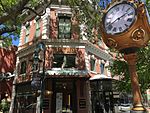National Loan and Exchange Bank Building
1903 establishments in South CarolinaBank buildings on the National Register of Historic Places in South CarolinaBuildings and structures completed in 1903Buildings and structures in Columbia, South CarolinaColumbia, South Carolina Registered Historic Place stubs ... and 5 more
Columbia, South Carolina building and structure stubsNational Register of Historic Places in Columbia, South CarolinaOffice buildings on the National Register of Historic Places in South CarolinaSkyscraper office buildings in South CarolinaSkyscrapers in South Carolina

National Loan and Exchange Bank Building, also known as the Barringer Building, is a historic bank and office building located at 1338 Main Street, Columbia, South Carolina. It was built in 1903, and is a 12-story, steel frame building faced in brick and stone. It measures 184 feet high and is considered Columbia's first skyscraper. The building was owned by the Barringer Corporation from 1953 until 1974.It was added to the National Register of Historic Places in 1979.
Excerpt from the Wikipedia article National Loan and Exchange Bank Building (License: CC BY-SA 3.0, Authors, Images).National Loan and Exchange Bank Building
Main Street, Columbia Main Street District
Geographical coordinates (GPS) Address Nearby Places Show on map
Geographical coordinates (GPS)
| Latitude | Longitude |
|---|---|
| N 34.003611111111 ° | E -81.034722222222 ° |
Address
Main Street 1401
29201 Columbia, Main Street District
South Carolina, United States
Open on Google Maps









